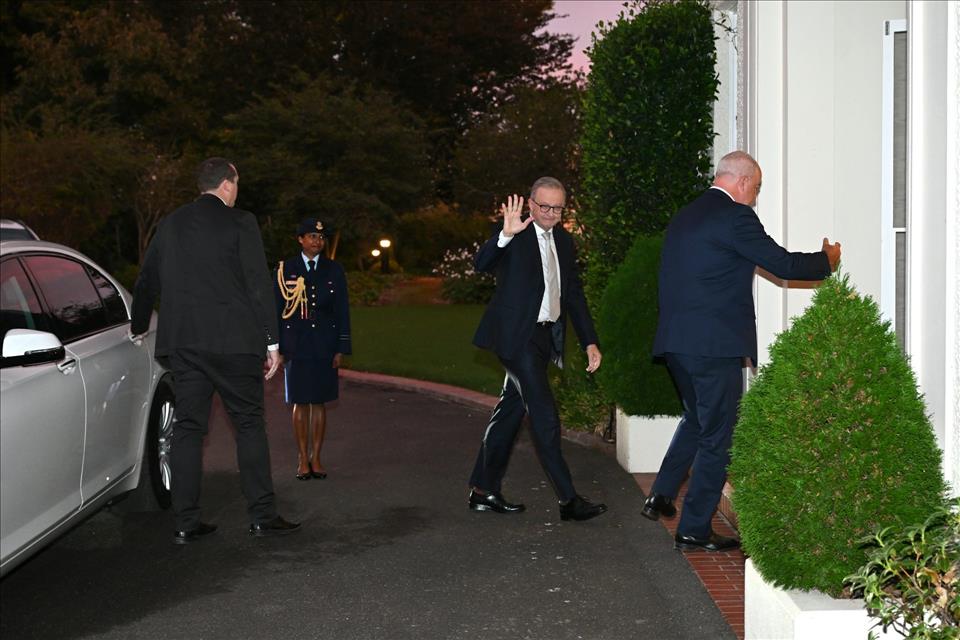
Albanese Calls May 3 Election, With Cost Of Living The Central Battleground
Prime Minister Anthony Albanese visited Governor-General Sam Mostyn at Yarralumla first thing on Friday morning.
Later he told an 8am news conference at parliament house the election choice was“between Labor's plan to keep building or Peter Dutton's plan to cut.
"Only Labor has the plan to make you better off over the next three years,” he said.“Now is not the time for cutting and wrecking, punching down.”
Less than a week after the federal budget and following an earlier delay caused by Cyclone Alfred, the formal campaign starts with government and opposition neck and neck and minority government considered a real possibility.
But in recent days, the government has gained more momentum and Labor enters the campaign more confident than at the start of the year.
The aggregated January-March quarterly Newspoll had the Coalition leading Labor 51-49%, but Albanese leading Peter Dutton as preferred PM 45% to 40%. A YouGov poll published March 21 had Labor and Coalition on 50-50. Polling only shows a snapshot of the present, and the campaign itself could be crucial to the election result.
This is the fourth consecutive election launched off the back of a budget, with both sides this week bidding for voters' support with big handouts.
Labor pushed through legislation for its $17 billion tax cut, the first stage of which comes in mid next year. Opposition leader Peter Dutton in his budget reply promised a 12-month halving of excise on petrol and diesel and a gas reservation scheme.
Labor goes into the election with 78 seats in the lower house, and the Coalition with 57 (counting the seats of two recent Liberal defectors). The large crossbench includes four Greens and half a dozen“teals”.
With a majority being 76 seats in the new 150-seat parliament, the Coalition needs to win 19 seats for an outright majority. This would require a uniform swing of 5.3% (although swings are not uniform). A swing of less than 1% could take Labor into minority. The Coalition would need a swing of about 3.6% to end with more seats than the government. While all states are important if the result is close, Victoria and NSW are regarded as the crucial battlegrounds.
If the Coalition won, it would be the first time that a first-term government had been defeated since 1931, during the great depression.
Since the end of the second world war, while all first term governments have been reelected, each saw a two-party swing against them.
One challenge for Albanese is that he has only a tiny majority, providing little buffer against a swing.
The combined vote of the major parties will be something to watch, with the vote steadily declining from 85.47% of the vote just 19 years ago at the 2007 election, to only 68.28% at the 2022 election.
Labor won the last election with a two-party vote of
52.13% to the Coalition's 47.87%.
As of December 31 2024, 17,939,818 Australians were enrolled to vote.
The start of the formal campaign follows a long“faux” campaign in which both leaders have been travelling the length and breadth of the country non-stop, with the government making a series of major spending announcement but the opposition holding back on policy.
Marginal seats based on the redistribution* Seat with a sitting ALP member ** Seat with a sitting Liberal member *** Warringah MP Zali Steggall was elected before the 2022 'teals', but is regarded as one of them. Antony Green's ABC Electoral Pendulum

Legal Disclaimer:
MENAFN provides the information “as is” without warranty of any kind. We do not accept any responsibility or liability for the accuracy, content, images, videos, licenses, completeness, legality, or reliability of the information contained in this article. If you have any complaints or copyright issues related to this article, kindly contact the provider above.






















Comments
No comment